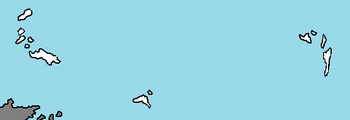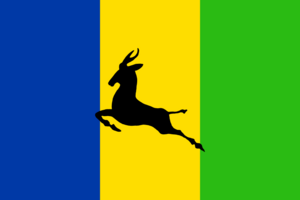Jumbosa
Confederation of Jumbosa "Confédération des Jumbése" | |
|---|---|
|
Flag | |
| Motto: "Mother Sea and Father land shall lead me to Paradise my home" | |
| Anthem: ""Oh Sun, shine thyn light on min fields"" | |
 Map of Confederation of Jumbosa | |
| Capital | Port Joseph(2010-2025) |
| Largest city | Albertine |
| Official languages | Lémanche, Laruba |
| Recognised regional languages | Zamu´hu |
| Ethnic groups (2020) | Jumbosians(58%), Other(13%), Lémanchenié(11%), Larubian(8%), Zawu´hili(7%), insert later(3%) |
| Demonym(s) | Jumbosian |
| Government | Democratic Parliamentarian Republic |
| Dolman Haban | |
| Jospin Ramsamy | |
| Legislature | Jumbosian Parliament |
| Independence from Constantio and Zoygaria1822 | |
• Treaty of Albertine | 03-09-1822 |
| Population | |
• 2021 estimate | 7.2 million |
| Currency | Jumbosian Hamba |
| Date format | dd-mm-yyyy |
| Driving side | right |
| Calling code | +72 |
| Internet TLD | .jm |
Jumbosa, officially known as the Confederation of Jumbosa (Lémanche: Confederation des Jumbése) is a democratic confederative parliamentarian republic located on the continent of Nortua in the Coalition of Crown Albatross. It has maritime borders with Utobania and Trive to the north, Siniapore to the northwest, and Great Epsilon to the south. The confederation consists of three Etat fédérals, Sainte-Marie, Victoire and Des Mann. The capital is Port Joseph(between 2010 and 2025), while the largest city is Albertine. Jumbosa has a total population of 2.7 million. 67% of Jumbosians live in urban areas, which cover 1.3% of the entire land area. The highest concentration is in the western Etat fédéral Sainte-Marie and the central Etat fédéral Victoire.
Jumbosa is a confederative republic and a parliamentary democracy, with legislative power vested in the 113-member unicameral Parlament. It is a confederation, currently divided into 3 federal states, 14 counties and 67 municipalities. The 3 federal states have large juridical power when it comes to domestic issues, and all federal states have their regional parliaments(legislative power), called Parledrale, lead by an Etat Gouverneur elected by the said regional Parledrale. Jumbosa ranks very highly in protection of civil liberties, economic competitiveness, prosperity and human development, even though they have been criticized for their privatized healthcare, privatized educational system and a low income equality.
Jumbosa is a series of multiple archipelagos which extend from 180 miles north of central Adula to the range of the Utobanian peninsula in the Nortua Sea, classifying it as an extension of central Nortua despite relative ambiguity and interpretation from geological experts. Nouvile is the largest island and most populous, being home to the capital of Albertine, while Swunata is the second largest. Other notable islands include Tomasique, Remeaux, and Les Paradia. There are at least 300 islands in the chains. The climate can be mild and wet or very dry, because of the north-east trade winds. The individual islands in the Jumbosa archipelagos tend to have distinct microclimates and the classifications range mainly from semi-arid to desert.
Like other island nations, Jumbosa faces unique environmental issues created by its proximity to the ocean, and small size. These include pressures on water resources, natural ecosystems, and deforestation more generally. Existing issues on the island are further made worse by climate change, where, unlike other island nations affected by climate change, sea level rise, increased weather variability, create increased pressures on the communities on the islands and the land, through processes like coastal erosion and saltwater intrusion.
Etymology
The name Jumbése is a fairly new word, and it was created for the creation of the confederacy, because the signers of the Albertine treaty didn't want to alienate any of the islands' inhabitants by picking an already existing name. According to several books and interviews with people who signed the treaty, was the name Jumbése created by combining the Lémanche word for alliance("Jemaine") and the Zwutana word for island("Bunsa"). Jumbése therefore literally translates to Alliance Islands, and means Alliance of Islands.
History
Prehistory of the Jumbosan Islands
The rise of civilisations in Sainte-Marie
The Age of Thunder
The Constantio Empire
The Confederacy of Jumbosa
Geography
Jumbosa is a series of multiple archipelagos which extend from 180 miles north of central Adula to the range of the Utobanian peninsula in the Nortua Sea, classifying it as an extension of central Nortua despite relative ambiguity and interpretation from geological experts. -- is the largest island and most populous, being home to the capital of Albertine, while -- is the second largest. Other notable islands include --, --, and --. There are at least 300 islands in the chains.
Climate
According to the position of the islands with respect to the north-east trade winds, the climate can be mild and wet or very dry. Several native species form laurisilva forests. As a consequence, the individual islands in the Jumbosa archipelagos tend to have distinct microclimates. Those islands such as --, --, and -- lying to the west of the archipelago have a climate which is influenced by the moist Siniapore Current. They are well vegetated even at low levels and have extensive tracts of sub-tropical laurisilva forest. As one travels west toward the Nortuan coast, the influence of the current diminishes, and the islands become increasingly arid. The climate is subtropical (tropical at the coastline) and generally semidesertic, moderated by the sea and in summer by the trade winds. There are a number of microclimates and the classifications range mainly from semi-arid to desert. There also exists a subtropical humid climate which is very influenced by the sea in the middle of the islands of --, --, and --, where laurisilva cloud forests grow.
Environment
Like other island nations, Jumbosa faces unique environmental issues created by its proximity to the ocean, and small size. These include pressures on water resources, natural ecosystems, and deforestation more generally. Existing issues on the island are further made worse by climate change, where, unlike other island nations affected by climate change, sea level rise, increased weather variability, create increased pressures on the communities on the islands and the land, through processes like coastal erosion and saltwater intrusion.
Politics and government
Military
Foreign relations
Economy
Energy
Industry
Infrastructure
Transport
Demographics
Education
Religion
Culture
Music and art
The Jumbosian music industry is small yet well known for producing regionally renowned and to a lesser extent internationally renowned musicians. Jumbosa established a Hall of Grates for musicians that have been seen as important for Jumbosa's music scene in 2008. The Hall of Greats have since then got genre specific branches, like the Hall of Greats for Folk music created 2012 and the Hall of Greats for Rock and Metal created 2015. The first artist to ever be inducted to Jumbosa's Hall of Greats was Jumbosian Folk singer and songwriter Emmanuel Nbone, for his importance of giving Jumbosa an identity through music and spreading Island music and Jumbosan folk to the rest of the world. Emmanuel Nbone sadly died in 1988 and was therefore inducted after his death. A statue was raised of Nbone during his induction outside of the Hall of Greats in Albertine. He was also honored by Jumbosa's Hall of Greats for Folk music, by changing name to Emmanuel Nbone's Hall of Greats.
Jumbosa became a melt pot of different folk music traditions in the creation of the confederation. In Sainte-Marie was the music before the confederation percussion and rhythmic based, with a big emphasis on aggressive rhythms and shouting vocals. This music became known as Katunda, which basically means Spirit music in Zamu´hu. The music was characterized by aggressive and chaotic percussion accompanied with chanting vocals about the nature spirits. Katunda is sometimes referred to as Old Folk. In the end of the 19th century emerged a new type of folk music inspired by the cultures and instruments brought by migrants and sailors. This new kind of melting pot of music became known as New Folk, and the music was more focused on string instruments such as guitar and mandolin than drums. The lyrics became less mystical and more based on the real life of the people living in Sainte-Marie, and the vocals became softer and calmer. Many music historians call the 1930s to 1950s as the golden age of New Folk, with artists such as Emmanuel Nbone, Tanu Mtoto and Corallie Blanchet-Koumba.
Music in Des Mann before the colonisation of the Constantio Empire were mostly based on howling vocals, mysterious chanting and percussion instruments mixed in with early variants of flutes. Even after centuries of colonization and the importation of new instruments and cultures, survived the old music of Des Mann, which later became known as Ntu´´ana, or Roar of Thunder, which was how colonizators and other tribes percieved it.
It took until the rock waves of the 1960s and 1970s until New Folk’s position as the most dominant genre was challenged, and even then it took until the Electronic music revolution in the late 1980s until New Folk no longer was relevant in Sainte-Marie. Jumbosa is in modern times famous for its extreme metal scene, calypso scene, New Folk revival scene and pop scene. Famous modern time artists are The Axiom Enigma(Extreme metal), Théodorine Aristide(Calypso), Djougine(New Folk Revival) and Red Crayon(pop).
